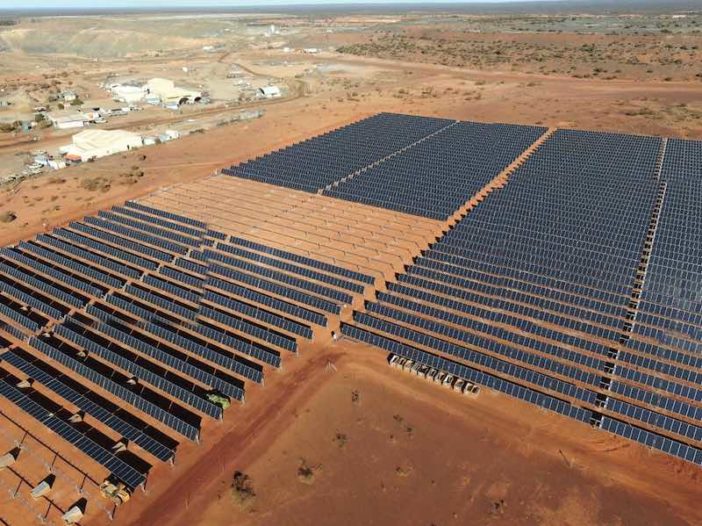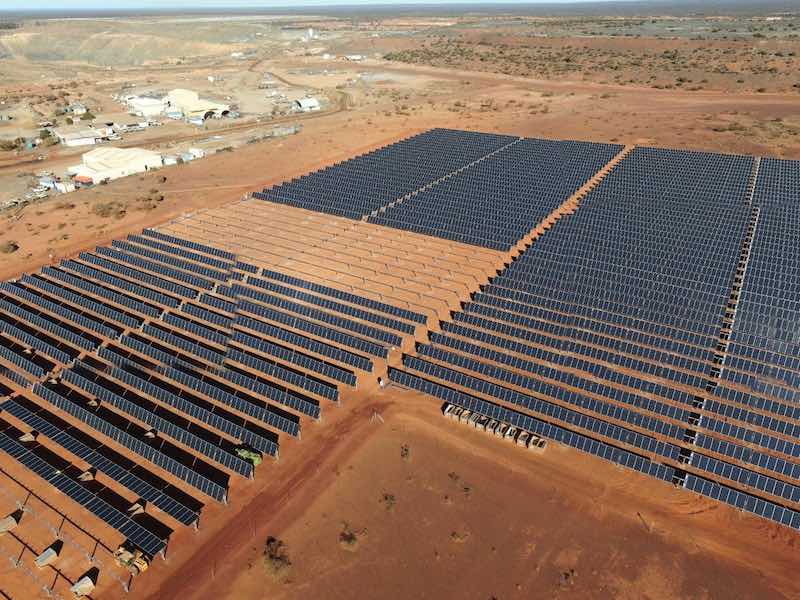

A hybrid wind, solar, battery and gas microgrid being built to power a Western Australian gold mine has won backing from the Australian Renewable Energy Agency.
ARENA will provide $13.5 million in funding towards the “Australia-first” project that is being built to power the Agnew Gold Mine, owned by a subsidiary of the South Africa-based Gold Fields Group.
The hybrid microgrid will combine a five-turbine, 18MW wind farm with a 10,000-panel, 4MW solar farm and a 13MW/4MWh battery system (BESS), underpinned by a 16MW gas engine power station, and back-up diesel. The all-up cost, including gas and diesel and pipeline, is $112 million.
In a statement on Wednesday, ARENA said the project would mark the first time the Australian mining sector has used wind generation as part of a large hybrid microgrid.
That said, a strikingly similar remote hybrid renewables project – although this one grid-connected – was also tapped for funding by ARENA on Wednesday.
That project, which is combining refurbished (second-hand) wind turbines, with solar and battery storage to power a garnet mine near Kalbarri, is due to be completed by the end of this year.
The Gold Fields project at Agnew – due for completion in 2020, the solar is already installed – is being designed, built and will be owned and operated under a 10-year contract by distributed energy outfit EDL.
The combination of wind, solar and battery is expected to provide the mine with up to 60 per cent of its energy requirements, and – at times – will meet all of its power needs with renewables.
Gold Fields has also committed to use innovative operational practices including dynamic load shedding, renewable resource forecasting and IPP-controlled load management to maximise the use of renewables while ensuring system security.
“The project Gold Fields is undertaking will provide a blueprint for other companies to deploy similar off-grid energy solutions and demonstrate a pathway for commercialisation, helping to decarbonise the mining and resources sector,” said ARENA chief Darren Miller in a statement.
“We’re excited to see more mining companies taking up renewable options and Gold Fields’ project comprising solar, wind and battery is helping to position into a more reliable and sustainable energy supply to call upon for the life of the mine.”
Gold Fields also is installing 8MW of solar and 1MW/2MWh lithium ion battery at its Granny Smith mine, also in W.A. that will be completed by Aggreko later this year.
Gold Fields vice president of operations Graeme Owens told the Energy and Mines conference in Perth the company was looking to add more renewables and more storage at its operations, to save costs and cut emissions.
EDL – which owns and operates the award-nominated Coober Pedy Renewable Hybrid Project, which has at times taken the remote opal mining town in South Australia to 100% renewables (once for a period of 81 hours straight) – said it had seen increasing momentum towards hybrid energy solutions, particularly in remote off-grid locations.
“This project represents a major step in Australia’s journey to sustainable energy and EDL is pleased to be an active contributor in this transition,” said EDL CEO James Harman in comments.
“We have leveraged learnings from demonstrated success in other hybrid renewable projects, which will enable us to provide Agnew Gold Mine with greater than 50 per cent renewable energy over the long term, without compromising power quality or reliability.”
For Gold Fields, the Agnew hybrid microgrid project is about maximising energy security while also minimising energy costs, and cutting the company’s carbon footprint.
EDL is delivering the project in two stages: Stage 1, due to be completed this year, is the new off-grid 23MW power station incorporating 16MW gas and 3MW diesel generation and 4MW solar PV.
Stage 2 includes the wind component (18MW), the battery and an advanced micro-grid control system, with construction recently started and due for completion in 2020.

Sophie is editor of One Step Off The Grid and deputy editor of its sister site, Renew Economy. Sophie has been writing about clean energy for more than a decade.

